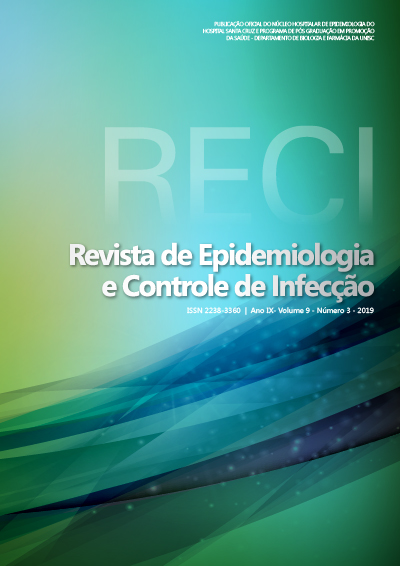Incidence of mechanical ventilator-associated pneumonia and the most prevalent etiological agents in an intensive care unit in the interior of São Paulo
DOI:
https://doi.org/10.17058/reci.v9i3.12869Keywords:
Respiratory Tract Infections. Respiration, artificial. Pneumonia. Infection Control. Epidemiology.Abstract
Background and Objectives: To assess the rate and incidence density of ventilator-associated pneumonia and to identify the most common etiological agents in the culture of tracheal secretion in an adult intensive care unit. Methods: Descriptive, cross-sectional, retrospective study with a quantitative approach, carried out from January 1st to December 31st, 2014, based on data on rates and incidence density of ventilator-associated pneumonia and isolated microorganisms found in tracheal secretion culture of patients admitted to the adult intensive care unit in a 12-month period. Results: The mean annual rate of ventilator-associated pneumonia was 5.5% and higher rates were found in the second semester. The mean incidence density was 17.97 ventilator-associated pneumonia/1000 patient-days on mechanical ventilation. Nine microorganisms isolated from tracheal secretion culture were identified. The most prevalent pathogens identified in this study were Klebsiella pneumoniae and Pseudomonas aeruginosa. Conclusion: The rate and incidence density of ventilator-associated pneumonia showed a non-expected increase each month for 3 months in a row during the study period. Real time surveillance and incidence oscillation must be valued to adjust sectoral strategies to protect the health of individuals undergoing treatment.Downloads
Downloads
Published
How to Cite
Issue
Section
License
The author must state that the paper is original (has not been published previously), not infringing any copyright or other ownership right involving third parties. Once the paper is submitted, the Journal reserves the right to make normative changes, such as spelling and grammar, in order to maintain the language standard, but respecting the author’s style. The published papers become ownership of RECI, considering that all the opinions expressed by the authors are their responsibility. Because we are an open access journal, we allow free use of articles in educational and scientific applications provided the source is cited under the Creative Commons CC-BY license.


